The charging companies are positioning themselves for profitability in different ways.
ChargePoint sells stations and offers various degrees of operational support, but doesn’t get paid from the charging itself. A typical client might be a Silicon Valley company that offers its employees free charging at work as a perk. If a particular station gets little use, ChargePoint still gets paid.
“I wouldn’t want a driver as a customer, because I think I’d starve to death,” said Pasquale Romano, ChargePoint’s CEO, in an interview. “There’s not a lot of money in electricity.”
Other companies, like EVgo, own the chargers they deploy and make money each time they’re used.
Blink, meanwhile, takes both approaches at once. The company prefers to own and operate as many of its stations as possible, but if a property owner wants to buy the chargers from Blink outright, that’s fine, too. The biggest priority is locking up good sites in high-demand areas, according to CEO Michael Farkas.
“Right now, this is a land grab,” Farkas said in an interview. “For us this is about getting as many locations as we can, and we’ll deal with profitability later.”
Volta Industries, which plans to go public in a SPAC deal this year, adds advertising to the mix. Its chargers come with 55-inch digital screens. A grocery store can place chargers in its parking lot and bombard customers with ads for specific products inside.
Beam Global offers a self-contained unit with a canopy of solar cells powering a battery and a charger. It doesn’t require digging up the parking lot to install a power line. “You can tell the world you’re driving on sunshine for free,” CEO Desmond Wheatley said in an interview.
There’s good reason for Beam to focus on easy installation and self-generated power. The time and cost to install a grid-connected charging station can be significant, often involving construction permits and hooking up to the local utility. The equipment itself can range from less than $2,000 for a slower, basic charger to more than $100,000 for the most powerful models, according to BNEF. Increased production should bring down the hardware costs, but for now, they’re another reason some of the companies struggle to turn a profit.
“It’s still early days,” said Colin Rusch, a senior analyst who covers the industry for Oppenheimer & Co. “Like with any early-stage industry, you’ve got to give it some time, until they get to scale.”


